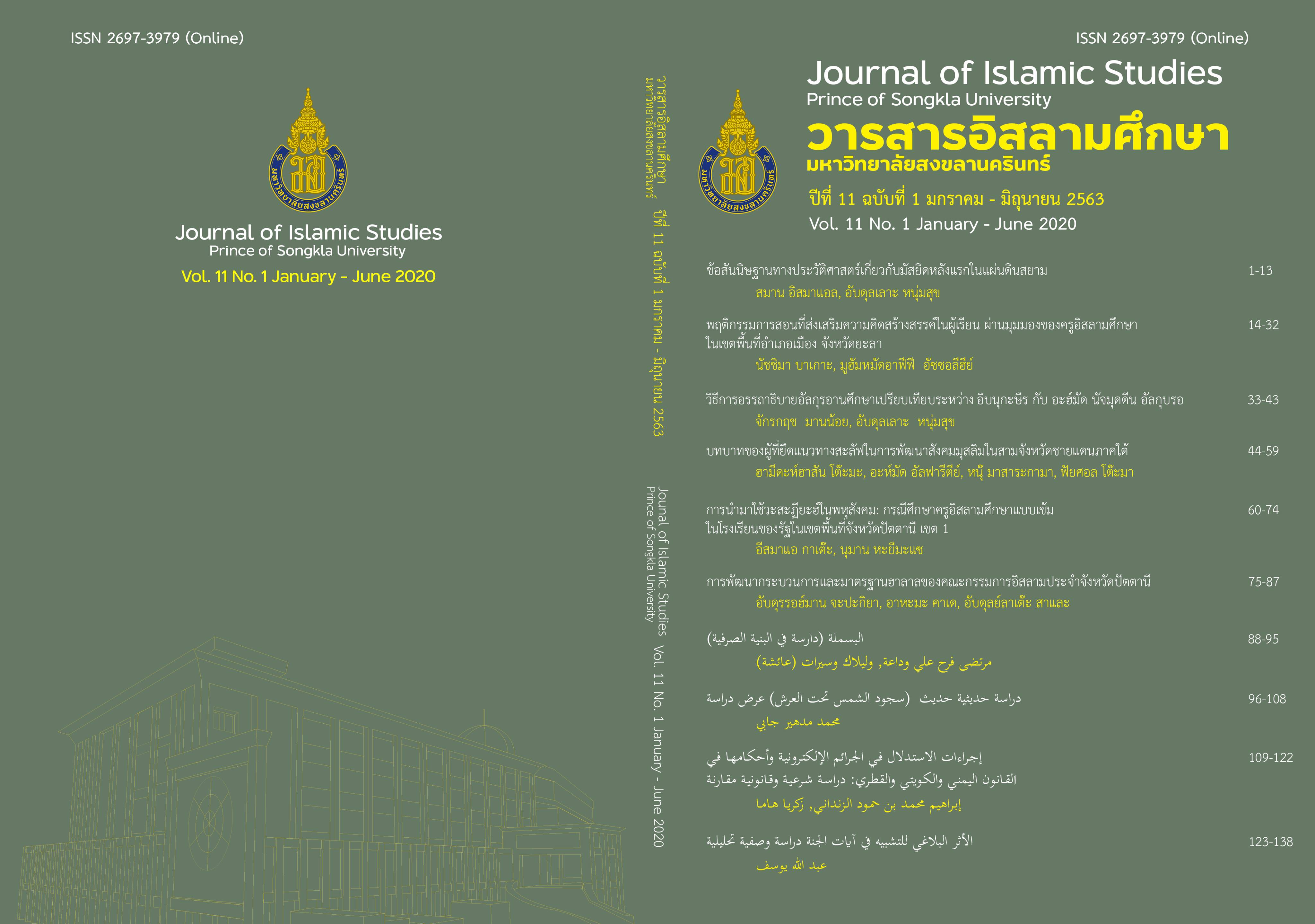บทบาทของผู้ที่ยึดแนวทางสะลัฟในการพัฒนาสังคมมุสลิมในสามจังหวัดชายแดนภาคใต้
คำสำคัญ:
บทบาท, สะลัฟ, พัฒนาสังคม, สามจังหวัดภาคใต้บทคัดย่อ
วัตถุประสงค์ของการวิจัยครั้งนี้เพื่อศึกษา 1) ทฤษฎี แนวคิดของแนวทางสะลัฟโดยสังเขป 2) ประวัติการเข้ามาของแนวทางสะลัฟในสามจังหวัดชายแดนภาคใต้ และ 3) รูปแบบการพัฒนาสังคมมุสลิมของผู้ที่ยึดแนวทางสะลัฟในสามจังหวัดชายแดนภาคใต้ เป็นวิจัยเชิงคุณภาพประกอบด้วยข้อมูลเอกสารและภาคสนาม มีประชากรกลุ่มตัวอย่าง 45 คน จากสามจังหวัดชายแดนภาคใต้จังหวัดละ 15 คน โดยใช้เครื่องมือ การสัมภาษณ์เชิงลึกแบบมีโครงสร้าง การสังเกตแบบมีส่วนร่วมและการสนทนากลุ่มย่อยโดยวิเคราะห์ข้อมูลเชิงพรรณนา ผลการวิจัยพบว่า 1) สะลัฟเชิงภาษาแปลว่า ชนรุ่นก่อน และเชิงวิชาการ หมายถึงบรรดาอุละมาอ์ที่สืบทอดมรดกจากท่านนบีมุหัมมัดe[1] ในเรื่องสัจธรรม ซึ่งมีชีวิตอยู่ในช่วงสามศตวรรษแรกของฮิจเราะฮ์ศักราชและท่านนบีได้ยืนยันว่า บุคคลเหล่านี้มีความประเสริฐยิ่ง ซึ่งมีแนวคิดคือจะใช้ตัวบทอัลกุรอาน และอัลหะดีษเป็นหลักฐานในการอ้างอิงก่อนหลักฐานทางสติปัญญา การยึดความเข้าใจของบรรดาเศาะหาบะฮฺ ตาบิอุต-ตาบิอีน และบรรดานักวิชาการมุสลิมร่วมสมัยที่ตามแนวทางสะลัฟ เป็นต้น 2) แนวทางนี้ได้เข้ามาในจังหวัดชายแดนภาคใต้ เริ่มจากกรุงเทพมหานครและทยอยลงสู่จังหวัดปัตตานีประมาณ ปี ค.ศ. 1943 เป็นต้นมา และ 3) ผู้ที่ยึดแนวทางสะลัฟใช้รูปแบบต่าง ๆ ในการพัฒนาสังคมมุสลิมคือ จัดตั้งสถาบันการศึกษาทุกระดับและสร้างมัสยิดเพิ่มมากขึ้นพร้อมฟื้นฟู จัดตั้งสถานที่อาศัยและดูแลเด็กกำพร้าสหกรณ์อิสลามที่ครบวงจรทั่วทุกจังหวัดในภาคใต้ ชาวไทยมุสลิมให้ความสำคัญกับการศึกษาควบคู่สายศาสนาและสามัญพร้อม ๆ กัน และสตรีไทยมุสลิมได้แต่งกายที่ถูกต้องตามหลักการศาสนา เป็นต้น
[1]อ่านว่า “ศ็อลลัลลอฮุอะลัยฮิวะสัลลัม” เป็นการพรภาวนาต่อท้ายชื่อของท่านนบีมุหัมมัด มีความหมายว่า “ขอให้อัลลอฮฺ ทรงสดุดีและให้ความสันติแด่ท่าน” ซึ่งเป็นมารยาทที่ชาวมุสลิมควรกล่าวทุกครั้งหลังจากพาดพิง ที่มีการกล่าวถึงท่าน
เอกสารอ้างอิง
ซุฟอัม อุษมาน และคณะ. (2547). ขบวนการวะฮาบีย์นิยามและความหมาย. กรุงเทพฯ : อิสลามิคอะเคเดมี.
ฝ่ายกองการศึกษา. (2554). มูลนิธิอัล-ฟุรอนเพื่อการศึกษาและสังคมสงเคราะห์. วารสารอัล-ฟุรกอน 1 (2), 25-30.
มหาวิทยาลัยอิสลามยะลา. (2554). เนื่องในโอกาสจัดพิธีมอบปริญญารัฐประศาสนศาสตร์ดุษฎีบัณฑิตกิตติมศักดิ์ แด่ Y.A.Bhg.Tun Dr.Mahadhir Bin Mohamad มหาธีร์ โมหัมมัด. วารสารเพื่อการประชาสัมพันธ์. มหาวิทยาลัยอิสลามยะลา. 13(15), 4-5.
มูหะมัด คอยา. (2550). บทบาทมัสยิดในจังหวัด ปัตตานีในการเผยแผ่อิสลามและความรู้ กรณีศึกษามัสยิดอิบาดุรรอฮ มาน ตำบลปูยุดอำเภอเมือง จังหวัดปัตตานี (วิทยานิพนธ์ศิลปศาสตร์มหาบัณฑิต). มหาวิทยาลัยสงขลานครินทร์, วิทยาเขตปัตตานี: ปัตตานี.
วินัย ครุวรรณพัฒน. (2523). ทัศนะของคนไทยใน 4 จังหวัด ภาคใต้. (รายงานการวิจัย) ม.ป.ท.
วิมลชัย คำปุ้ย และทัดดาว ลออโรจน์วงศ์. (2536). บทบาทของผู้นำอาสาพัฒนาชุมชนในทัศนะของข้าราชการในระดับตำบล. (รายงานการวิจัย). กองวิชาการและแผนงาน กรมการพัฒนาชุมชน กระทรวงมหาดไทย.
สมาคมนักเรียนเก่าอาหรับประเทศไทย.ฮ.ศ. (1419). พระมหาคัมภีร์อัลกุรอานพร้อมความหมายภาษาไทย. อัลมะดีนะฮฺ อัลมุเนาวะเราะฮฺ: ศูนย์กษัตริย์ฟะฮัดเพื่อการพิมพ์อัลกุรอาน.
เสริมศักดิ์ วิศาลาภรณ์และคณะ. (2552). สภาพการจัดการศึกษาในจังหวัดชายแดนภาคใต้.(รายงานการวิจัย) กรุงเทพฯ : สำนักงานเลขาธิการสภาการศึกษา.
อาหามะกอซี กาซอ. (2547). การปฏิรูปสังคมของเคาะลีฟะฮฺอุมัรฺ อิบนุ อัลอะซีซ (วิทยานิพนธ์ศิลปศาสตร์มหาบัณฑิต). มหาวิทยาลัยสงขลานครินทร์, วิทยาเขตปัตตานี: ปัตตานี.
อาหะมะ หะยีสะมะแอ. (2549). บทบาทสถาบันการศึกษาอิสลามชั้นสูงในการเผยแพร่วิทยาการและส่งเสริมวัฒนธรรมความรู้ต่อชุมชนใน จังหวัดชายแดนภาคใต้ ศึกษาโครงการวิทยาการอิสลามเพื่อชุมชน (เค้าโครงวิทยานิพนธ์ศิลปศาสตร์มหาบัณฑิต). มหาวิทยาลัยอิสลามยะลา.
อัชชาฟิอีย์, มุหัมมัด อิดรีส. (1980). อัรริสาละฮฺ. (เล่ม 2). เบรุต : ดาร์ อัลกุตุบ อัลอิลมียะฮ์.
อัตติรมีษีย์, อบี อีซา มุหัมมัด บิน อีซา บิน ษัรฺวะฮฺ. (1994). สุนัน อัตติรมีษีย์. (เล่มที่.4). เบรุต : ดาร์ อัลฟิกร์.
อัตตะมีมีย์, ตะกียุดดีน อะห์มัด. (1996). มัจญ์มูอะฮฺ อัลฟัตวา. อัรริยาฎ: อัละบีกาน.
อัลกุวัยศีย์. (2002). อัรรอด์ อะลา ยะฮฺมียะฮฺ วะ อัซซะนาดีเกาะฮฺ. ม.ป.พ.
อัลบุคอรีย์, อบี อับดุลลอฮฺ มุหัมมัด บิน อิสมาอีล. (1997). เศาะหีหฺ อัลบุคอรีย์. (เล่มที่ 14). อัรริยาฏ : ดาร์ อัสสะลาม.
อัลมัสอูดีย์, อบี อัลหะสัน อะลี บิน หุสัยน์ บิน อะลีย์. (ม.ป.ป). มุรูจญ์ อัษษะฮับวะ มะอาดิน อัลเญาฮัร์. (เล่ม 2). เบรุต: อัลมักตะบะฮฺ อัลอัศรียะฮฺ.
อัลอักลฺ, นาศิรฺ บิน อับดุลการีม. (1998). อัลเคาะวาริจญ์ เอาวัล อัลฟิรอก ฟิ อัตตารีค อัลอิสลาม.อัรริยาฎ: ดาร์ อัลวะฏอน.
อัลอุษัยมีน, เชค มุหัมมัด บิน ศอลิหฺ (2010). หลักความเชื่อของมุสลิม. ซุฟอัม อุษมาน, (ผู้แปลและเรียบเรียง). ม.ป.พ.
อิบนุ ตัยมียะฮฺ. (1980). กิตาบ อัซซิยาเราะฮฺ. เล่มที่ 14. เบรุต : อัลมักตะบะฮฺ อัลหะยะฮ์.
อิบนุ มันซูรฺ, มุหัมมัด บิน มุกรอม บิน อาลี บิน อะห์มัด อันนะศอรีย์. (ม.ป.ป). ลิสาน อัลอาหรับ. เล่มที่ 3 .ไคโร : ดาร์ อัลมะอารีฟ.
ฮามีดะห์ มาสาระกามาและคณะ. (2554). บทบาทมัจญลีส อัลอิลมีย์ในการพัฒนาคุณธรรมจริยธรรมและคุณภาพชีวิตชาวไทยมุสลิมในสามจังหวัดชายแดนภาคใต้. (รายงานการวิจัย). กรุงเทพ : สำนักงานคณะกรรมการอุดมศึกษา.
Dagor-ha, Nurdin Abdullah (1997). Dakwah Islamiyah di Selatan Thailand : suatu Kajian Tentang perkembangannya Antara Tahun 1960-1991 masihi. Kuala Lumpur: University Malaya.
ดาวน์โหลด
เผยแพร่แล้ว
รูปแบบการอ้างอิง
ฉบับ
ประเภทบทความ
สัญญาอนุญาต
บทความทุกเรื่อง ที่ได้รับการตีพิมพ์ในวารสารอิสลามศึกษาเป็นแนวคิดของผู้เขียน มิใช่เป็นความคิดเห็นคณะผู้จัดทำและมิใช่ความรับผิดชอบของคณะวิทยาการอิสลาม กองบรรณาธิการไม่สงวนสิทธิ์การคัดลอก แต่ให้มีการอ้างอิงแสดงที่มา






